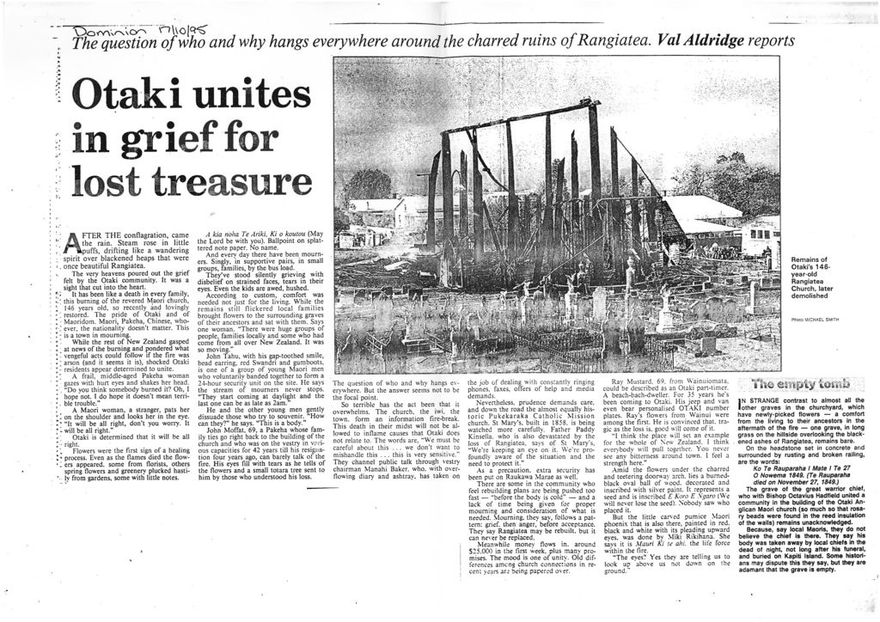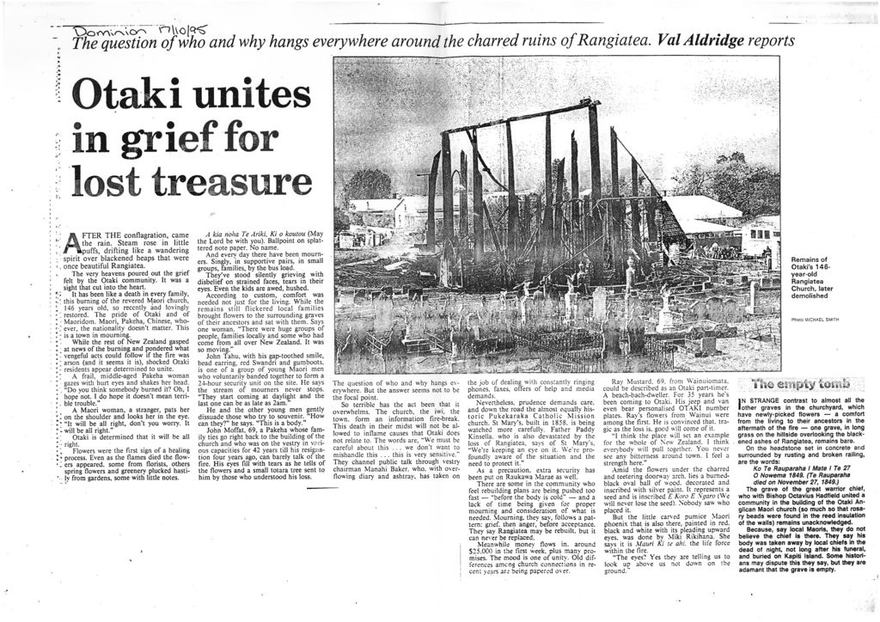Otaki unites in grief for lost treasure
- Description
After the conflagration, came the rain. Steam rose in little puffs, drifting like a wandering spirit over blackened heaps that were once beautiful Rangiatea.
The very heavens poured out the grief felt by the Otaki community. It was a sight that cut into the heart.
It has been like a death in every family, this burning of the revered Maori church, 146 years old, so recently and lovingly restored. The pride of Otaki and of Maoridom. Maori, Pakeha, Chinese, whoever, the nationality doesn't matter. This is a town in mourning.
While the rest of New Zealand gasped at news of the burning and pondered what vengeful acts could follow if the fire was arson (and it seems it is), shocked Otaki residents appear determined to unite.
A frail, middle-aged Pakeha woman gazes with hurt eyes and shakes her head. "Do you think somebody burned it? Oh, I hope not. I do hope it doesn't mean terrible trouble."
A Maori woman, a stranger, pats her on the shoulder and looks her in the eye. "It will be all right, don't you worry. It will be all right."
Otaki is determined that it will be all right.
Flowers were the first sign of a healing process. Even as the flames died the flowers appeared, some from florists, others spring flowers and greenery plucked hastily from gardens, some with little notes.
A kia noha Te Ariki, Ki o koutou (May the Lord be with you). Ballpoint on splattered note paper. No name.
And every day there have been mourners. Singly, in supportive pairs, in small groups, families, by the bus load.
They've stood silently grieving with disbelief on strained faces, tears in their eyes. Even the kids are awed, hushed.
According to custom, comfort was needed not just for the living. While the remains still flickered local families brought flowers to the surrounding graves of their ancestors and sat with them. Says one woman. "There were huge groups of people, families locally and some who had come from all over New Zealand. It was so moving."
John Tahu, with his gap-toothed smile, bead earring, red Swandri and gumboots, is one of a group of young Maori men who voluntarily banded together to form a 24-hour security unit on the site. He says the stream of mourners never stops. "They start coming at daylight and the last one can be as late as 2am."
He and the other young men gently dissuade those who try to souvenir. "How can they?" he says. "This is a body."
John Moffat, 69, a Pakeha whose family ties go right back to the building of the church and who was on the vestry in various capacities for 42 years till his resignation four years ago, can barely talk of the fire. His eyes fill with tears as he tells of the flowers and a small totara tree sent to him by those who understood his loss.
The question of who and why hangs everywhere. But the answer seems not to be the focal point.
So terrible has the act been that it overwhelms. The church, the iwi, the town form an information fire-break. This death in their midst will not be allowed to inflame causes that Otaki does not relate to. The words are, "We must be careful about this ... we don't want to mishandle this ... this is very sensitive." They channel public talk through vestry chairman Manahi Baker, who, with over-flowing diary and ashtray, has taken on the job of dealing with constantly ringing phones, faxes, offers of help and media demands.
Nevertheless, prudence demands care, and down the road the almost equally historic Pukekaraka Catholic Mission church, St Mary's, built in 1858, is being watched more carefully. Father Paddy Kinsella, who is also devastated by the loss of Rangiatea, says of St Mary's, "We're keeping an eye on it. We’re profoundly aware of the situation and the need to protect it."
As a precaution, extra security has been put on Raukawa Marae as well.
There are some in the community who feel rebuilding plans are being pushed too fast — "before the body is cold" — and a lack of time being given for proper mourning and consideration of what is needed. Mourning, they say, follows a pattern: grief, then anger, before acceptance. They say Rangiatea may be rebuilt, but it can never be replaced.
Meanwhile money flows in. around $25,000 in the first week, plus many promises. The mood is one of unity. Old differences among church connections in recent years are being papered over.
Ray Mustard, 69, from Wainuiomata, could be described as an Otaki part-timer. A beach-bach-dweller. For 35 years he's been coming to Otaki. His jeep and van even bear personalised OTAKI number plates. Ray's flowers from Wainui were among the first. He is convinced that, tragic as the loss is, good will come of it.
"I think the place will set an example for the whole of New Zealand. I think everybody will pull together. You never see any bitterness around town. I feel a strength here.
"Amid the flowers under the charred and teetering doorway arch. lies a burned-black oval ball of wood, decorated and inscribed with silver paint. It represents a seed and is inscribed E Koro E Argaro (We Will never lose the seed). Nobody saw who placed it.
But the little carved pumice Maori phoenix that is also there, painted in red, black and white with its pleading upward eyes, was done by Miki Rikihana. She says it is Mauri Ki te ahi, the life force within the fire. "The eyes? Yes they are telling us to look up above us not down on the ground.
The empty tomb
IN STRANGE contrast to almost all the other graves in the churchyard, which have newly-picked flowers — a comfort from the living to their ancestors in the aftermath of the fire — one grave, in long grass on the hillside overlooking the blackened ashes of Rangiatea, remains bare. On the headstone set in concrete and surrounded by rusting and broken railing, are the words:
Ko Te Rauparaha I Mate 1 Te 27
0 Nowema 1849. (Te Rauparaha
died on November 27, 1849.)The grave of the great warrior chief, who with Bishop Octavius Hadfield united a community in the building of the Otaki Anglican Maori church (so much so that rosary beads were found in the reed insulation of the walls) remains unacknowledged.
Because, say local Maoris, they do not believe the chief is there. They say his body was taken away by local chiefs in the dead of night, not long after his funeral, and buried on Kapiti Island. Some historians may dispute this they say, but they are adamant that the grave is empty.
Identification
- Date
- October 17, 1995
Taxonomy
- Community Tags


